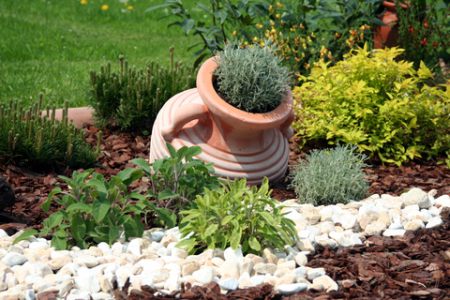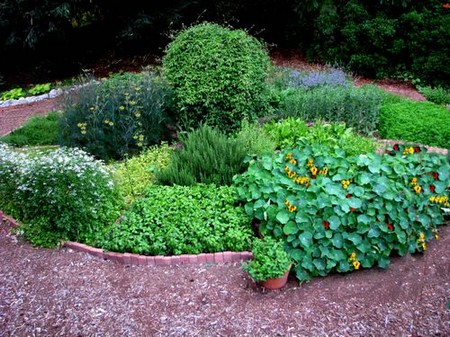Best Way to Understand the Growing Conditions for Herbs
Success with growing herbs in the garden improves when you plant them in the growing conditions they prefer – that is, the soil and site of their natural habitat. Many herbs prefer well-drained or very well-drained soil. Those such as lavender that are at home in the wild on rocky Mediterranean hillsides or equivalent locations prefer sunny sites with good air circulation where the soil drains rapidly. Such plants are identifiable by common visual attributes: grey to silvery leaves, often covered with fine hairs, are usually long and slender in shape to reduce the surface area (which helps minimize the loss of water from the plant through transpiration). These adaptations help plants survive in a hot, sunny habitat where, because of low rainfall and evaporation of water from the soil, water is not readily available to the plant.
A few herbs prefer or tolerate damp or wet positions, and often (but not always) these also tolerate partial shade. Marshmallow, Joe Pye weed, and all angelicas are herbs that in the wild grow in marshes, wetlands, and alongside streams; they are the best choices for constantly moist to wet soils and boggy areas.
Most herbs grow best in full sun, at least six hours of direct sunlight a day. A few herbs -those native to open woodland areas, scrubland, and hedgerows – are happy in partial shade. The best herbs for partial shade include angelica, bee balm, boneset, chervil, cowslip, foxglove, lady’s mantle, lemon balm, meadowsweet, all of the mints, perennial chamomile, sorrel, and valerian. The ideal soil pH for most herbs is 6.3 to 7.0 (slightly acidic to neutral), although they will tolerate a slightly wider range.
If existing conditions are not ideally suited for a particular herb, it is sometimes possible to ameliorate them. In a sunny site, plant tall herbs to create a small area of partial shade. Adding organic matter such as compost to a heavy clay soil will improve drainage and please plants that require last-draining soil. Gravel mulches around herbs help channel water from the crowns so plants dry out more quickly; this may improve survival in rainy climates. To lower the pH of a soil, add plenty of organic matter or peat moss, and mulch with pine needles. To raise pH, add lime in the form of limestone, oystershell, or dolomite lime; follow amounts recommended on the label for the pH measurement of your soil. Where soils are especially difficult (thin and stony, or extremely alkaline) the best solution is often to plant herbs in a raised bed of imported soil or in containers. Many herbs tolerate less-than-ideal conditions, so it is always worth experimenting to see what plants you can grow in your garden.
Hardiness
You will also need to take into account a plants frost hardiness. While hardy herbs are able to withstand low temperatures, tender herbs such as basil and nasturtiums will succumb in freezing weather. Hardiness zones show the minimum temperatures at which a plant is likely to survive.
The zones only provide a guide, however. You may be able to grow herbs that are of marginal hardiness for your area if you can protect them from extreme temperature changes: for example, if you plant them in a protected microclimate, if they are insulated by nearly continuous snow cover during the winter, or if you protect them with a loose cover of evergreen boughs (perhaps from discarded holiday decorations). You can grow tender herbs and those not hardy in your climate in containers and move them indoors in freezing weather.
Categories
Advertisements
Recent Articles
 How to Understand Bed Sizes – A Small Guide
How to Understand Bed Sizes – A Small Guide How to Select Some Must Have Kitchen Accessories
How to Select Some Must Have Kitchen Accessories Best Way to Change a Car Tire
Best Way to Change a Car Tire Best Way to Write an Affirmation
Best Way to Write an Affirmation Best Way to Take Charge of Your Financial Life
Best Way to Take Charge of Your Financial Life Best Way to Survive a Party When You Don’t Know Anyone
Best Way to Survive a Party When You Don’t Know Anyone Best Way to Stop Self Sabotaging Yourself
Best Way to Stop Self Sabotaging Yourself Best Way to Start Journal Writing
Best Way to Start Journal Writing Best Way to Speak with a Powerful Voice
Best Way to Speak with a Powerful Voice Best Way to Simplify Your Life
Best Way to Simplify Your Life Best Way to Respond to a Put-Down
Best Way to Respond to a Put-Down Best Way to Reduce Acne Breakouts
Best Way to Reduce Acne Breakouts Best Way to Recover from Dining Disasters
Best Way to Recover from Dining Disasters Best Way to Quit Your Job Gracefully
Best Way to Quit Your Job Gracefully Best Way to Make Your Own Website
Best Way to Make Your Own Website



Leave a Reply